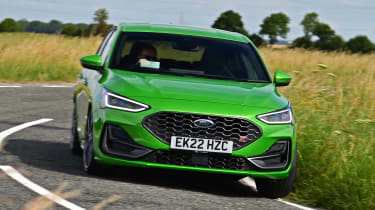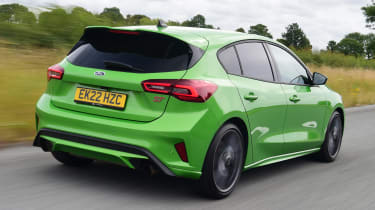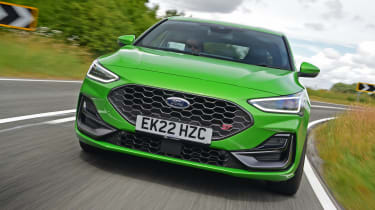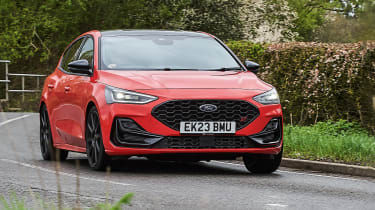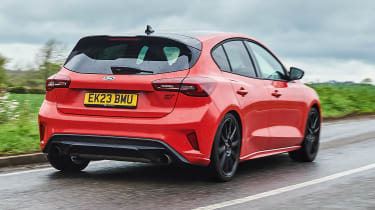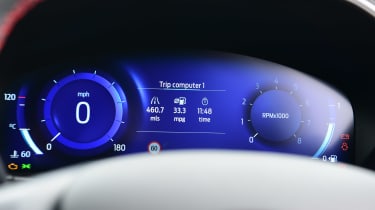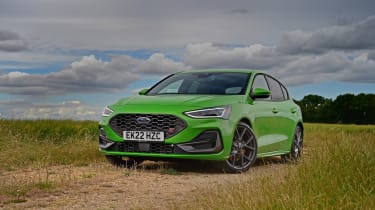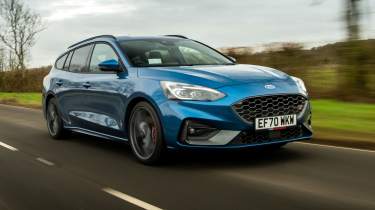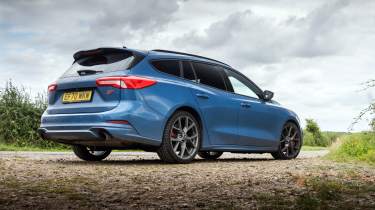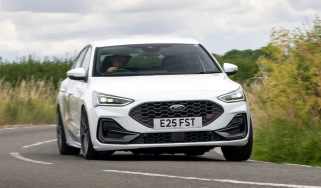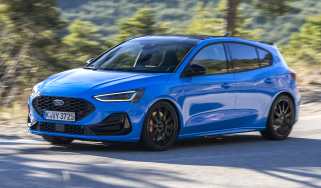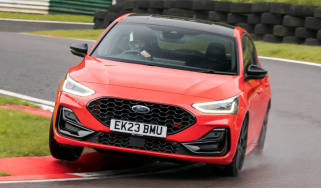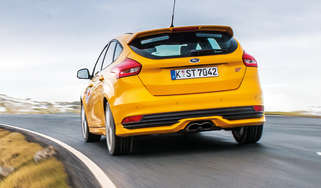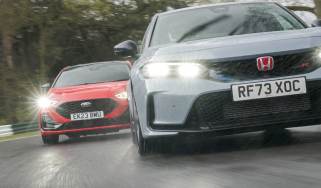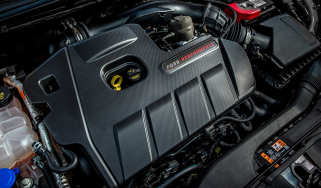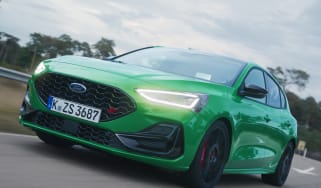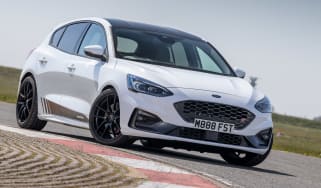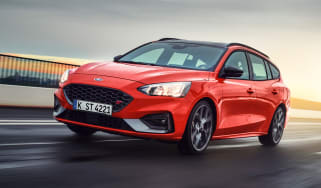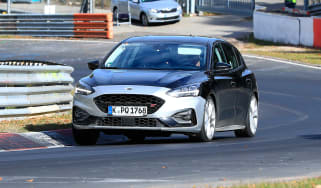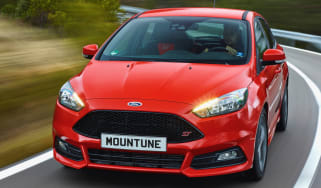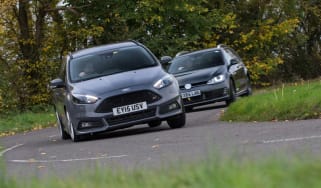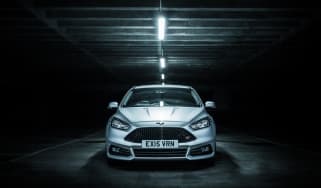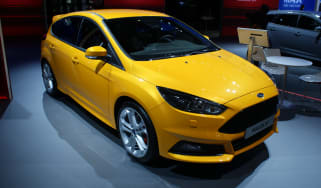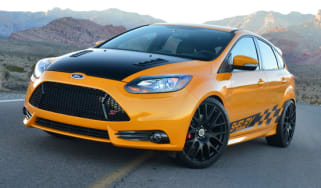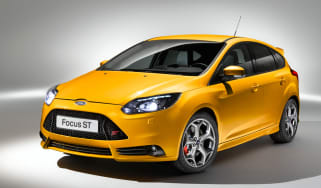Used Ford Focus ST (Mk4, 2019-2025) review – Ford has killed its last remaining hot hatch
The Mk4 Focus ST went out as an imperfect hot hatchback, but one with appeal and impressive capability if you don’t mind some rough edges
Since it launched in 2019, the Mk4 Ford Focus ST has had a tough time standing out amongst the midsize hot hatch crowd. Compared to the Honda Civic Type Rs and Hyundai i30 Ns of the world, it hasn’t quite had the precision or finesse to compete – even if its outright capability has been in the same ballpark.
But in a world where petrol hot hatches are increasingly thin on the ground, that doesn’t seem to matter as much. We’re glad the ST has been able to live on in its traditional form for so long, and for its flaws, it’s still a quick, engaging hot hatch with its own dynamic flavour. That made it all the more disappointing when Ford stopped production of the Focus near the end of 2025, in the process axing the ST – its last remaining hot hatch.
> The Ford Focus is dead: how the VW Golf rival redefined everyday driving
By the end of its life the Mk4 had evolved into a more complete and capable performance car, with a facelift arriving in 2022 and new variants like the Edition and Track Pack giving the handling a keener edge. The latter turned the ST into a genuinely fun circuit machine – objectively slower and less capable than a Type R, but arguably just as enjoyable on a bumpy, technical track.
More reviews
Group tests
In-depth reviews
Reviews
- ZeroNine Ford Focus ST review – Ferrari 599 pulling power in a hatchback
- Used Ford Focus ST Edition (Mk4, 2021 - 2025) review – a Honda Civic Type R rival for £20k
- Ford Focus 2025 review – is Ford killing its best car?
- Used Ford Focus RS500 (Mk2, 2010 - 2011): review, specs and buying guide for the original hyperhatch
All in, the Mk4 ST won’t go down as an all-time great fast Ford, but as one of the last affordable petrol hot hatches it’s well worth celebrating.
Engine, gearbox and technical highlights
- 2.3-litre four-pot with a choice of manual or automatic gearboxes
- Favours torque over power, with 276bhp and a healthy 310lb ft
- Edition and Track Pack models bring useful suspension and brake upgrades
By hot hatch standards there’s a fairly big lump sitting under the ST’s bonnet in the form of a turbocharged 2.3-litre, or 2261cc if you prefer, four-cylinder engine. If it sounds familiar, it’s because it’s the same engine found largely in American-market Fords, including but not limited to the Ranger pick-up and Bronco.
This explains why the ST’s torque figure of 310lb ft is so much more impressive than its 276bhp, beating out all main rivals for torque but lagging in power. This manifests itself in the engine’s delivery, with a solid shove in the mid-range that can trouble the front wheels and have the wheel jittering in your hands. Keep the throttle pinned, though, and the engine’s enthusiasm wanes as the revs rise, and doesn’t quite portray the excitable nature we all expect in a hot hatchback.
With a useful shot of torque from the 2.3-litre unit the ST is capable of expectedly strong performance. Get a clean launch – something made easier with launch control – and the ST will scrabble to 62mph in 5.7sec, and run on to 155mph.
Ford incorporates a sort of anti-lag system for the turbo, but it’s a far cry from the flame-spitting systems that kept setting 1980s rally cars on fire. Instead, the Focus keeps the electronically controlled throttle valve open for short periods of time after lifting off to keep the turbo spinning. The system does work, but is only really obvious with large sustained inputs on and off the throttle, which is only generally relevant on track.
Speaking of which, the ST gained a circuit-oriented make-over in 2021 with the introduction of the Edition version, featuring manually adjustable KW coilover suspension and lightweight 19-inch alloys. Following a facelift in 2022, similar upgrades were offered as part of a Track Pack. The KW kit rides 10mm lower than standard (this can be dropped by a further 15mm if you're handy with spanners), and there were also bespoke Pirelli P Zero Corsa tyres and uprated Brembo brakes (with larger 363mm discs up front).
A six-speed manual transmission was standard fit, with a conventional seven-speed auto optional. Power is sent to the front wheels alone via an electronically controlled limited-slip differential. The automatic is a standard torque converter-style unit rather than a dual-clutch, and has insistent, if not entirely speedy, shifts. The bigger problem, though, is the extra inertia it appears to add to the driveline, making the already slightly blunt engine feel even softer. There are paddles behind the steering wheel, though, and the previous car’s irritating dial-like gear selector has also been swapped out for a traditional lever.
Kerb weights for the ST hatchback and estate are about average in context of rivals, coming in at 1433kg and 1468kg respectively.
Driver’s note
‘The Track Pack also includes a bespoke Race Track drive mode within the touchscreen’s menus, relaxing the stability control and pepping up the steering, throttle and engine maps. The steering feels super-responsive, and the Focus’s tail follows its nose faithfully. It feels faster in a straight line than many sports cars, and resolutely stable under braking.’ – James Taylor, evo deputy editor
Performance, ride and handling
- Grunty engine hits hard, but lacks top-end sparkle
- Sharp, agile and adjustable chassis
- Tack-sharp steering doesn’t have much in the way of natural feel
In some ways the ST is more old school than some rivals, in that it feels unashamedly turbocharged, and quite rowdy when you dump all of its performance to the road. It brings back an era of managing traction and torque steer, which adds character but makes it a busier, less honed experience than the very best hot hatches.
Things are quite tame in Normal mode, but switch to Sport mode and you get a quicker acting throttle. There is some lag low down, but when the boost does build it generates torque in one big lump, making it feel more powerful than it actually is. The issue is that the power and torque don’t hang around right the way to the red line, making the last 1500rpm up to the red line something of an arduous task. Best short-shift and surf the chunkier mid-range.
Once up and running, traction is actually pretty good whether on a straight road or powering out of a corner, but the differential doesn’t feel quite as aggressive in its lock-up capability as the unit found in an i30 N. The seven-speed auto also isn’t the sharpest in the class, lacking the responsiveness of Hyundai and Volkswagen’s dual-clutch units, but the shifts are swift enough to match the manual’s 0-62mph time.
Point the nose at a corner and the ST feels very keen, and builds on the Mk4 Focus’s sweet standard chassis. There’s a fundamental dynamism to it, with a stiff structure minimally impacted by cornering loads, good responses, excellent body control and gymnastic agility.
It also has some playful handling traits, particularly on a track where there’s more room to exploit it, but for most of the time it feels like you’re spending your effort managing the powertrain and its lack of linearity. The engine also makes its weight known at times – despite its locking differential the ST can fall into understeer if you’re too heavy handed with the steering and throttle.
The steering doesn’t particularly help. It’s quick at only two turns lock-to-lock, but the issue is that it lacks the finesse and consistency you’ll find in, say, a Hyundai i30 N. It moves unnaturally quickly off-centre, as if most of the car’s steering input happens in the first few degrees, and a springy, synthetic self-centring feel masks any real feedback.
The Track Pack doesn't rectify these snags, but with stiffer, adjustable KW coilovers, bigger brakes and sticky Pirelli P Zero Corsa tyres, it offers more focus and a better sense of connection than the standard car. It's eager to turn in, resistant to roll and more adjustable through a corner, with a stiff low-speed ride being the trade off for this extra cornering bite.
The standard brakes are sharp and have pretty good feedback, but definitely aren’t a dynamic highlight. They're more progressive and resilient than the brakes on a Golf or Leon, but even the upgraded Brembo setup fitted to Track Pack models doesn't have the reassuring bite of a Civic Type R, despite offering strong outright power.
Even with the uprated components, the ST lacks some depth and doesn’t feel as immediately intuitive as the smaller Fiesta ST. That won’t be a problem for some buyers, though, as its performance doesn’t come at the expense of much day-to-day usability. It’s not a perfect package, but it does have a distinctive character – one you won’t find in many modern hot hatches.
Driver’s note
‘The Track Pack is lovely around Cadwell. The front diff hooks the car around tricky turns like Mansfield like there’s a Scalextric groove on the racing line. It has a friendliness and malleability that make you feel like you’re driving well and not taking an awful lot out of the car.’ – John Barker, evo editor-at-Large
MPG and running costs
On paper the Focus ST is capable of a combined 33-36mpg whether hatchback or estate, with CO2 emissions of 179g/km for each. The auto shrinks this range down to 34-35mpg. In reality, the lower figures for both are about right for day-to-day use, so it’s not quite as thirsty as the Hyundai i30 N, but is noticeably less efficient than a Golf GTI or Audi S3.
The ST came with Michelin Pilot Sport 4 tyres as standard, but go for a Track Pack model and the Trofeo R tyres will be the biggest replacement cost – while they’re tough around a track, their lower wear rating will mean they’ll need replacing more often. If you’re a fan of trackdays, the Brembos will also be worked hard. While they’ll be more resilient to constant usage on a track than the standard brakes, make sure you factor in the cost of more expensive pads and discs when it’s time to replace them.
Ford’s 2.3-litre engine has also proven to be reliable, and despite the high torque figure, the engine is actually fairly under-stressed in this European tune. Build quality in this generation of Focus has also been proven to be resilient, and despite some average plastics on the inside, the cabin resists wear well.
Interior and technology
There’s little to complain about with the ST’s cabin, as while it’s not the most inspiring design, it’s functional and well built. The Mk4 has a considerably better driving position than previous models, too. The main touchpoints are sound, with good adjustment in wheel and seat. Some may find the flat-bottomed steering wheel rim a little chubby and the gearshift action a little notchy, but Ford has generally got the basics right, including well-spaced pedals.
The figure-hugging Recaros of the original Mk4 were replaced by Ford Performance seats as part of the 2022 facelift. They’re heated, electrically adjustable and just as supportive as the Recaros, and unlock a little more rear legroom thanks to their reprofiled seatback.
The other big upgrade for the facelift was Ford’s Sync 4 digital interface. This included a larger touchscreen that only just fits onto the dashboard’s ledge, looking sort of like a 60-inch television that’s been crammed onto a small mantelpiece. The updated system is a huge improvement, with much clearer graphics and higher resolution. The air con controls are integrated into the system, but they’re static on the screen, and aren’t a deal breaker (unlike those found in a modern Golf or Leon).
It’s also spacious inside, and the 375-litre boot is much more generous than the mean little cubby of its predecessor – it’s 60 litres larger than before.
Price and buying options
The Focus ST was available in two body styles and with two transmissions, and started from £37k in base form. For an auto estate you’d pay a shade under £40k, which sounds cheap in today’s market, but felt a little expensive when the Mk4 was new (Hyundai’s brilliant i30 N was around £2k cheaper). The aforementioned Track Pack included the aforementioned chassis upgrades (largely shared with the ST Edition) and commanded a chunky £3000 premium.
To compensate for the strong list price, all STs were very generously equipped. Highlights of its standard kit included 19-inch alloy wheels, adaptive dampers (hatchback only), a limited-slip differential and some very good sports seats that are heated and electrically adjustable. The 2022 facelift also brought in some new Matrix LED headlights and the new Sync 4 infotainment system.
Today you can pick up a tidy, early Mk4 for well under £20k, but if budget allows, we’d go for an ST Edition for just over £20k – or better yet, a facelifted Track Pack model. These come in at over £25k and pair chassis and brake upgrades with the improved interior of post-2022 models.
In terms of rivals, the Hyundai i30 N is the value proposition, costing from £18k. It’s not plush by any means, but to drive it’s a level above the Ford. The FK8-generation Honda Civic Type R is better still, but comes in at well over £20k for a tidy example.
Then there are more mainstream rivals from Volkswagen and Cupra. The Mk8 Golf GTI Clubsport is a more refined, rounded hot hatch than the Focus and costs from £25k on the used market, while Cupra’s hottest Leon hatch packs the same power for similar money.
Living with the Ford Focus ST Estate
The Focus ST is not a car to win group tests and appears to be caught in a strange hinterland. It’s not as hardcore as most rivals, nor as powerful in many cases, but it still commands a high price. However, specify the ST as an estate (and hence automatically without the hatch-only Performance Pack that includes adaptive dampers, a Track driving mode, launch control and rev-matching for the six-speed manual gearbox) and there’s a subtle change to what this car is all about. Suddenly, the mighty Civic Type R and entertaining i30 N don’t really figure. And perhaps the rather handsome, relatively understated and refreshingly simple formula could be a winning combination once the loan period extends from a mere week on dreamy, challenging roads to a full year in daily service.
Well, maybe. But let’s not let the ST off the hook too quickly. In 2021-form, it’s still a 2.3-litre turbocharged Focus with 276bhp, 310lb ft, three pedals, a stick and a limited-slip differential, and so it should be dynamically right on the money. Our car was £35,860 as tested. So, for me, the ST estate’s task was to effortlessly suck up all the drudgery of school runs and airport trips but still feel special when I was alone in the car and hoping for a bit of excitement, precision and straightforward fun. In many ways, this is the hardest brief in the business, which is why a great hot hatch can genuinely feel like the answer to every question you’ve ever asked.
The Focus ST never quite got there. However, there’s no doubt that the longer I spent in its company the more I appreciated the sheer utility. The Focus estate is a truly fantastic family car and as an ST it rips along at a fair old pace when it’s empty of cargo and kids, too. It’s fluid and accurate, the enhanced engine sound has more five-cylinder thrum than the Audi RS3 (despite it being a humble four) and I really enjoyed having a manual gearbox in my life on every journey. I’m lucky enough to never need to commute and even the school run takes place largely over country lanes, so gridlock isn’t a part of my routine. And on the rare occasion I found myself able to travel and on route to Heathrow, the ST’s anti-stall took what pain there could be out of inch-by-inch travel.
Weirdly, the ST also made me feel good every time I parked it up and took a glance back. The estate is a really handsome shape, the optional Ford Performance Blue paint (£800) is gorgeous and somehow I found myself thinking a mid-sized estate car wearing the blue oval was rather exotic looking. In a sea of crossovers and premium-badged but extremely generic shapes a humdrum estate car really stands out. Mad, but true. The Recaro seats are excellent, too. They are the highlight of an otherwise pretty ordinary interior, though. Everything works, everything is logical and the infotainment is pretty easy to operate, but the Focus does lack some sparkle aside from superbly supportive seats.
Dynamically the ST is a little flat, too. It’s actually really nicely balanced and very progressive at the limit, but this calmness in absolute terms isn’t matched in all the details on the journey to get there. For example, the front end is highly susceptible to torque-steer and always feels like it’s struggling to cope with the engine’s strong low- and mid-range performance. The fact that the rack is very quick exacerbates the situation and creates an impression that the car is never fully settled. The passive dampers work well up to a point but also feel stretched as you begin to indulge in the available performance. Suddenly, the Focus feels darty and distracted at the front end but rather soft-edged in terms of control and precision. The result is a slightly disconnected feeling. You’re making good progress but only by managing all of these conflicting dynamic traits.
So, whilst I will remember the ST fondly, it’s more for individual element or moments than as an overall experience. It looks great. Nothing broke (although the screen would very occasionally go blank until reset). The family and all their many, many inexplicable things fitted inside with ease. The flat-shift capability of the six-speed ’box was fun and having a manual was refreshing and satisfying in equal measure. However, the ST just lacks that last ten per cent of excitement, bite, aggression or simply character. It’s nice to have a brilliantly versatile family car that happens to go pretty quickly when necessary. But it would be even better to have an enthralling performance car that happens to be extremely practical, too.
| Date acquired | February 2021 |
| Duration of test | 12 months |
| Total test mileage | 14,585 |
| Overall mpg | 31.2 |
| Costs | £0 |
| Purchase price | £35,860 |
| Value today | c£24,000 |

